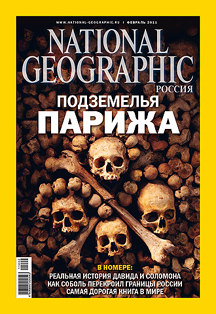National Geographic Russia in February

The February issue of National Geographic Russia comes with a unique insert: a map of the Paris catacombs. The Paris catacomb network includes thousands of kilometers of tunnels, one of the densest and oldest networks of its kind in the world. Here you can find canals and reservoirs, tombs, bank vaults and wine cellars that have been converted into nightclubs and galleries. But the most amazing underground structures are old limestone quarries that resemble a tangled web of tunnels.
These quarries and shafts were dug in the 19th century to extract stone used in constructing Paris’ magnificent buildings, including the Louvre and Notre Dame Cathedral. Later, farmers began cultivating mushrooms in the quarries, with annual harvests in the tons. During World War II, the quarries became part of the military theater of operations, with French Resistance fighters hiding in one section and German soldiers building bunkers in another. Today, a different group has brought life to the abandoned tunnels — a free, leaderless society that spends not only days, but sometimes even nights underground: fans of the Paris underground life, or self-styled “cataphiles.”
The map includes a chronology of the construction and expansion of the underground tunnels and structures, and notes places of interest and sites where historical events took place.
Also in this issue:
The Klondike of sable. Russia is indebted to sable for its enormous territory: For the sake of this priceless fur, our ancestors came to the Urals and settled in Siberia. Licensed hunting and poaching brought the sable to the brink of extinction several times. How is this animal, whose likeness graces the emblems of many cities, faring today?
The most expensive book. An example of 19th century book art featuring unique, life-size illustrations of birds, John James Audobon's book has broken its own record, becoming the most expensive print publication in the world for the second time.
Man-made reefs. Over time, sunken ships, tanks and armored personnel carriers are transformed into an underwater garden of seaweed and multi-colored sponges and corals. Such artificial reefs attract sea life and divers.
Did Solomon exist? Can archeologists use the Bible as a source for researching the ancient world, or should that method be discounted as unscientific? Eventually, scientists will probably find a solution worthy of Solomon himself.
The February issue goes on sale Feb. 1.


